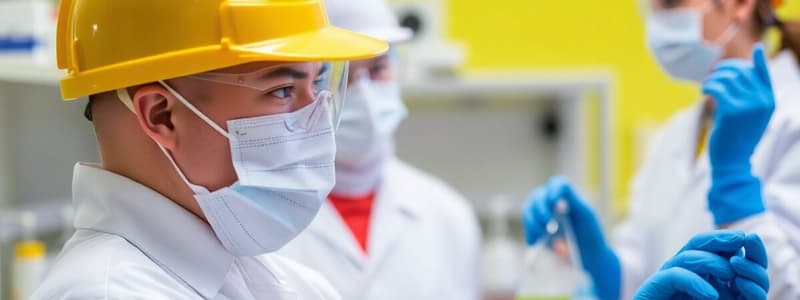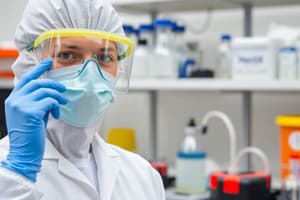Podcast
Questions and Answers
What is the primary purpose of wearing Personal Protective Equipment (PPE) in a lab?
What is the primary purpose of wearing Personal Protective Equipment (PPE) in a lab?
- To comply with legal regulations
- To improve visibility in the lab
- To look professional and competent
- To prevent exposure to hazardous materials (correct)
What should be done immediately after a chemical spill in the lab?
What should be done immediately after a chemical spill in the lab?
- Ignore it if it is a small amount
- Report it to a supervisor (correct)
- Leave the area quickly
- Try to clean it up yourself
Which method of data analysis is primarily used to make predictions about a population based on a sample?
Which method of data analysis is primarily used to make predictions about a population based on a sample?
- Data visualization
- Descriptive statistics
- Error analysis
- Inferential statistics (correct)
What is a key component of regression analysis?
What is a key component of regression analysis?
Which is NOT a recommended practice for chemical handling in the lab?
Which is NOT a recommended practice for chemical handling in the lab?
Which type of statistical test might you use to determine the relationship between two categorical variables?
Which type of statistical test might you use to determine the relationship between two categorical variables?
What should you do if you identify a source of systematic error in your experiment?
What should you do if you identify a source of systematic error in your experiment?
Which of the following is an essential component of hypothesis testing?
Which of the following is an essential component of hypothesis testing?
Flashcards are hidden until you start studying
Study Notes
Lab Safety Protocols
-
Personal Protective Equipment (PPE):
- Wear lab coats, gloves, and safety goggles at all times.
- Use face shields when necessary for protection against splashes.
-
Chemical Handling:
- Always read Material Safety Data Sheets (MSDS) before using chemicals.
- Label all chemical containers clearly with contents and hazards.
- Never pipette by mouth; use mechanical pipettes.
-
Emergency Procedures:
- Know the location of safety showers, eyewash stations, and fire extinguishers.
- Familiarize with emergency exits and evacuation routes.
- Report spills or accidents to a supervisor immediately.
-
Equipment Usage:
- Follow operating instructions for all lab equipment.
- Inspect equipment for damage before use.
- Keep work areas clean and organized to prevent accidents.
-
Waste Disposal:
- Dispose of chemical waste according to established guidelines.
- Separate hazardous waste from regular trash.
- Use designated containers for sharps and biohazard materials.
Data Analysis Methods
-
Descriptive Statistics:
- Summarizes data using measures such as mean, median, mode, and standard deviation.
- Provides a quick overview of data distribution and trends.
-
Inferential Statistics:
- Makes predictions or inferences about a population based on sample data.
- Common tests include t-tests, chi-square tests, and ANOVA.
-
Data Visualization:
- Use graphs (bar charts, histograms, scatter plots) to represent data clearly.
- Helps in identifying patterns, trends, and outliers.
-
Regression Analysis:
- Examines the relationship between variables; can be linear or nonlinear.
- Useful for predicting outcomes based on independent variables.
-
Software Tools:
- Familiarity with statistical software (e.g., SPSS, R, Python) for data analysis.
- Use spreadsheets (e.g., Excel) for basic analysis and visualization.
-
Error Analysis:
- Assess the uncertainty and reliability of data measurements.
- Identify sources of error (systematic vs. random) and minimize their effects.
-
Hypothesis Testing:
- Formulate null and alternative hypotheses.
- Use p-values to determine statistical significance and draw conclusions.
Lab Safety Protocols
- Always wear lab coats, gloves, and safety goggles as part of Personal Protective Equipment (PPE) to minimize exposure to hazardous materials.
- Use face shields when there is a risk of splashes to protect the face and eyes.
- Read Material Safety Data Sheets (MSDS) prior to using any chemicals to understand hazards and safety precautions associated with them.
- Clearly label all chemical containers with their contents and associated hazards to prevent misuse and accidents.
- Mechanical pipettes should always be used for transferring liquids; never pipette by mouth to avoid contamination and health risks.
- Familiarize yourself with the locations of safety showers, eyewash stations, and fire extinguishers for quick access in emergencies.
- Know the emergency exits and evacuation routes to ensure rapid response during an emergency situation.
- Report any spills or accidents to a supervisor immediately to ensure effective and timely response.
- Strictly follow operating instructions for all laboratory equipment to avoid accidents and equipment damage.
- Inspect equipment for any signs of damage prior to use to ensure safe operation.
- Maintain clean and organized work areas to reduce hazards and facilitate efficient lab functioning.
- Dispose of chemical waste according to the established guidelines to avoid environmental contamination and legal issues.
- Keep hazardous waste separate from regular trash and utilize specified containers for sharps and biohazard materials.
Data Analysis Methods
- Descriptive statistics provide a summary of data through measures like mean, median, mode, and standard deviation for quick insights into data distribution.
- Inferential statistics allows for making generalizations about a population based on sample data, employing tests such as t-tests, chi-square tests, and ANOVA.
- Data visualization tools, including bar charts, histograms, and scatter plots, effectively illustrate data, making patterns, trends, and outliers easier to identify.
- Regression analysis investigates relationships between variables, which may be linear or nonlinear, aiding in outcome predictions based on independent variables.
- Familiarity with statistical software like SPSS, R, and Python enhances data analysis capabilities, while spreadsheets like Excel suffice for basic tasks.
- Error analysis focuses on evaluating the uncertainty and reliability of measurements, distinguishing between systematic and random errors to mitigate their impact.
- Hypothesis testing involves forming null and alternative hypotheses and using p-values to assess statistical significance, guiding decision-making based on data findings.
Studying That Suits You
Use AI to generate personalized quizzes and flashcards to suit your learning preferences.




